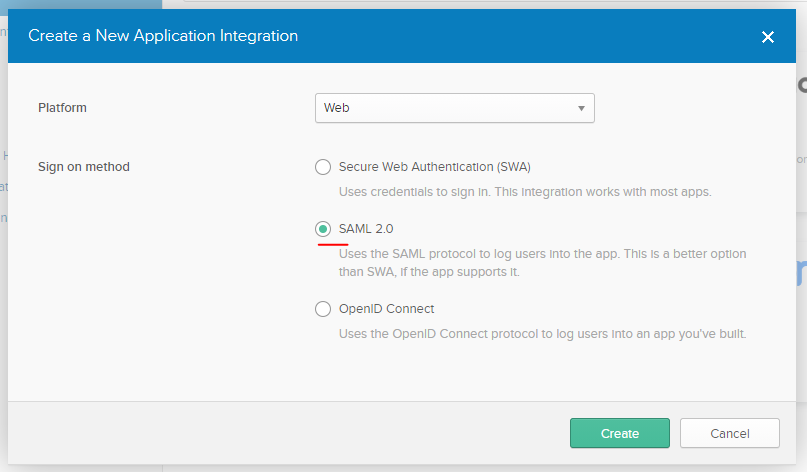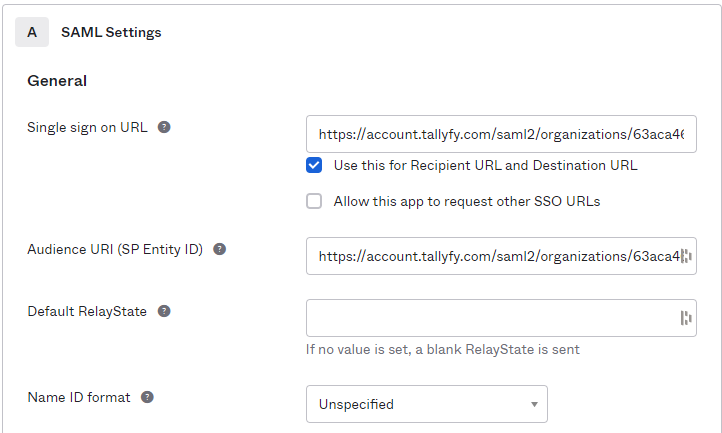Authentication > Integrate OneLogin SSO
Integrate Okta SSO
Want to connect Okta with Tallyfy? You’ll be setting up SAML-based Single Sign-On (SSO) that handles user authentication and creates accounts automatically. Takes about 30 minutes.
- Okta administrator account
- Tallyfy Professional or Enterprise plan
- SAML configuration values from Tallyfy Support
Here’s what you’ll do:
- Create an Okta SAML application
- Configure settings in both systems
- Turn on SSO and test it works
-
Sign in to the Okta Admin Console
-
Switch to Classic UI from the dropdown in the top left header

-
Navigate to Applications > Applications
-
Click Add Application

-
Select Create New App

-
In the modal dialog, select Web for Platform.
-
Select SAML 2.0 for Sign-on method.
-
Click Create.

- Enter “Tallyfy” as the application name
- Optionally upload the Tallyfy logo
- Click Next
First, you’ll need to grab Tallyfy’s SAML values - these tell Okta where to send login information:
- Contact Tallyfy Support to access your organization’s profile
- Navigate to the Org Settings tab
- Click on Add Configuration Details
- Locate the default SAML values section
Time to configure Okta with those values you just got:
-
Single Sign On URL: Enter the value from Tallyfy’s “SP ACS URL” field
-
Keep Use this for Recipient URL and Destination URL checkbox selected
-
Audience URI (SP Entity ID): Enter the value from Tallyfy’s “SP Entity ID” field

-
Click Show Advanced Settings
-
Change Authentication context class to X.509 Certificate
Next, tell Okta which user information to send to Tallyfy:
| Name | Name Format | Value |
|---|---|---|
| Unspecified | user.email | |
| FirstName | Unspecified | user.firstName |
| LastName | Unspecified | user.lastName |

- After adding the attributes, click Next.
- Select I’m an Okta customer adding an internal app
- Check This is an internal app that we have created
- Click Finish
-
Navigate to the Sign On tab in your Okta application

-
Scroll down and click View Setup Instructions

-
The page will display the SAML configuration details for the identity provider
- Send the Identity Provider Single Sign-On URL to Tallyfy Support.
- Send the Identity Provider Issuer to Tallyfy Support.
- Send the X.509 Certificate to Tallyfy Support.
- Tallyfy Support will configure these values in your organization’s SAML settings.
After Tallyfy Support confirms they’ve configured your settings:
- Toggle the SAML activation switch to enable SSO for your organization
Once everything’s set up:
- Get the Tallyfy login URL from the SAML configuration modal (Tallyfy Support provides this)
- Share this URL with your users who have access to the Okta application
Here’s how it works for your users:
- Already have a Tallyfy account? They’ll log in automatically
- Don’t have an account yet? Tallyfy creates one on their first login
This shows the complete authentication process from setup to user access.
What to notice:
- Steps 1-6 show the one-time setup collaboration between your Admin and Tallyfy Support
- Steps 7-14 demonstrate the actual user authentication flow that happens every login
- Tallyfy automatically creates accounts for new users (step 13) using the email and name attributes from Okta
Can’t log in? Check these things first:
- Is the user assigned to the Okta application?
- Are the attribute mappings exactly right? (names and formats matter)
- Are users using the SSO URL - not the regular Tallyfy login page?
- Still stuck? Contact Tallyfy Support
Authentication > Integrate JumpCloud SSO
Authentication > Integrate Microsoft Entra ID SSO
Authentication > Integrate Google Workspace
Was this helpful?
- 2025 Tallyfy, Inc.
- Privacy Policy
- Terms of Use
- Report Issue
- Trademarks